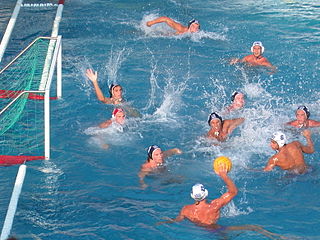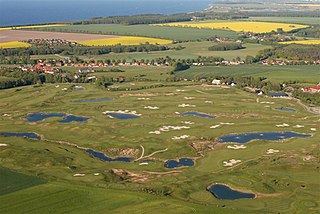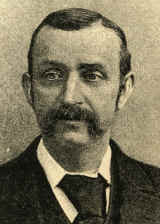
Tic-tac-toe, noughts and crosses, or Xs and Os is a paper-and-pencil game for two players who take turns marking the spaces in a three-by-three grid with X or O. The player who succeeds in placing three of their marks in a horizontal, vertical, or diagonal row is the winner. It is a solved game, with a forced draw assuming best play from both players.

Water polo is a competitive team sport played in water between two teams of seven players each. The game consists of four quarters in which the two teams attempt to score goals by throwing the ball into the opposing team's goal. The team with the most goals at the end of the game wins the match. Each team is made up of six field players and one goalkeeper. Excluding the goalkeeper, players participate in both offensive and defensive roles. Water polo is typically played in an all-deep pool so that players cannot touch the bottom.

In many team sports which involve scoring goals, the goalkeeper is a designated player charged with directly preventing the opposing team from scoring by blocking or intercepting opposing shots on goal. Such positions exist in bandy, rink bandy, camogie, association football, Gaelic football, international rules football, floorball, handball, hurling, field hockey, ice hockey, roller hockey, lacrosse, ringette, rinkball, water polo, and shinty as well as in other sports.
Canoe polo, also known as kayak polo, is one of the competitive disciplines of kayaking, known simply as "polo" by its aficionados.

A golf course is the grounds where the sport of golf is played. It consists of a series of holes, each consisting of a tee box, a fairway, the rough and other hazards, and a green with a cylindrical hole in the ground, known as a "cup". The cup holds a flagstick, known as a "pin". A standard round of golf consists of 18 holes. Most courses contain 18 holes; some share fairways or greens, and a subset has nine holes, played twice per round. Par-3 courses consist of nine or 18 holes all of which have a par of three strokes.

In sport, a goal may refer to either an instance of scoring, or to the physical structure or area where an attacking team must send the ball or puck in order to score points. The structure of a goal varies from sport to sport, and one is placed at or near each end of the playing field for each team to defend. For many sports, each goal structure usually consists of two vertical posts, called goal posts, supporting a horizontal crossbar. A goal line marked on the playing surface between the goal posts demarcates the goal area. Thus, the objective is to send the ball or puck between the goal posts, under or over the crossbar, and across the goal line. Other sports may have other types of structures or areas where the ball or puck must pass through, such as the basketball hoop.
For the Doctor Who serial, see Marco Polo.
The following is a glossary of the terminology currently used in the sport of golf. Where words in a sentence are also defined elsewhere in this article, they appear in italics. Old names for clubs can be found at Obsolete golf clubs.
The M-drop is a defensive scheme in the sport of water polo which is mainly used when the offensive team has a strong center or the center defender has lost position. The defense sets up in an M-shape, hence the name "M-Drop".
The following terms are used in water polo. Rules below reflect the latest FINA Water Polo Rules.

A screen is a blocking move by an offensive player in which they stand beside or behind a defender in order to free a teammate to either shoot a pass or drive in to score. In basketball and field lacrosse, it is also known as a pick. Screens can be on-ball, or off-ball. The two offensive players involved in setting the screen are known as the screener and the cutter.
Several sports related to volleyball have become popular. Indoor volleyball and beach volleyball are both events at the Olympics, and sitting volleyball is an event at the Paralympics. Other varieties are localised, or are played at an amateur or informal level.
Bradley Darrell Schumacher is an American former competition swimmer, water polo player, and Olympic gold medalist. Schumacher is a two-time, two-sport Olympian. He was a member of the winning relay teams at the 1996 Summer Olympics. Four years later, he was a member of the U.S. men's water polo team at the 2000 Summer Olympics.
Underwater ice hockey is a minor extreme sport that is a variant of ice hockey. It is played upside-down underneath frozen pools or ponds. Participants wear diving masks, fins and wetsuits and use the underside of the frozen surface as the playing area or rink for a floating puck. Competitors do not use any breathing apparatus, but instead surface for air every 30 seconds or so.

The Industry Hills Aquatic Club(IHAC) was a prominent USA Swimming club located in the City of Industry, California, from 1979 until August 2005. For almost three decades, the Club was a successful training ground for a considerable number of athletes, some achieving success at the highest levels of the sport, both nationally and internationally, such as the olympic games. In addition to swimming, the organization included water polo and diving teams composed of athletes achieving similar success. The Aquatic Center's pools also served the community as a popular venue for high school swim meets, youth swim lessons, and U.S. Masters Swimming.
The Spieker Aquatics Center is a 2,500-capacity stadium in Los Angeles, California used by UCLA water polo, swimming, and diving teams. The $14-million center was built in 2009 and is named for Tod and Catherine Spieker. Tod was a student-athlete at UCLA, competing from 1968–1971 in swimming.
Water volleyball is a competitive middle-court oriented water game. It can be played between two teams, each team consisting of 1 to 4 players, depending on the area of water in which the game is being played.

In water polo, the goalkeeper occupies a position as the last line of defense between the opponent's offence and their own team's goal, which is 2.8 m2 (30 sq ft).

The rules of water polo are the rules and regulations which cover the play, procedure, equipment and officiating of water polo. These rules are similar throughout the world, although slight variations do occur regionally and depending on the governing body. Governing bodies of water polo include FINA, the international governing organization for the rules; the NCAA, which govern the rules for collegiate matches in the United States; the NFHS, which govern the rules in high schools in the USA; and the IOC, which govern the rules at Olympic events.
Alexander "Alex" Obert is an American water polo player. He was a part of Team USA at the 2016 Summer Olympics, where the team finished in tenth place. Obert plays Center and is also currently listed as the captain of Team USA.










